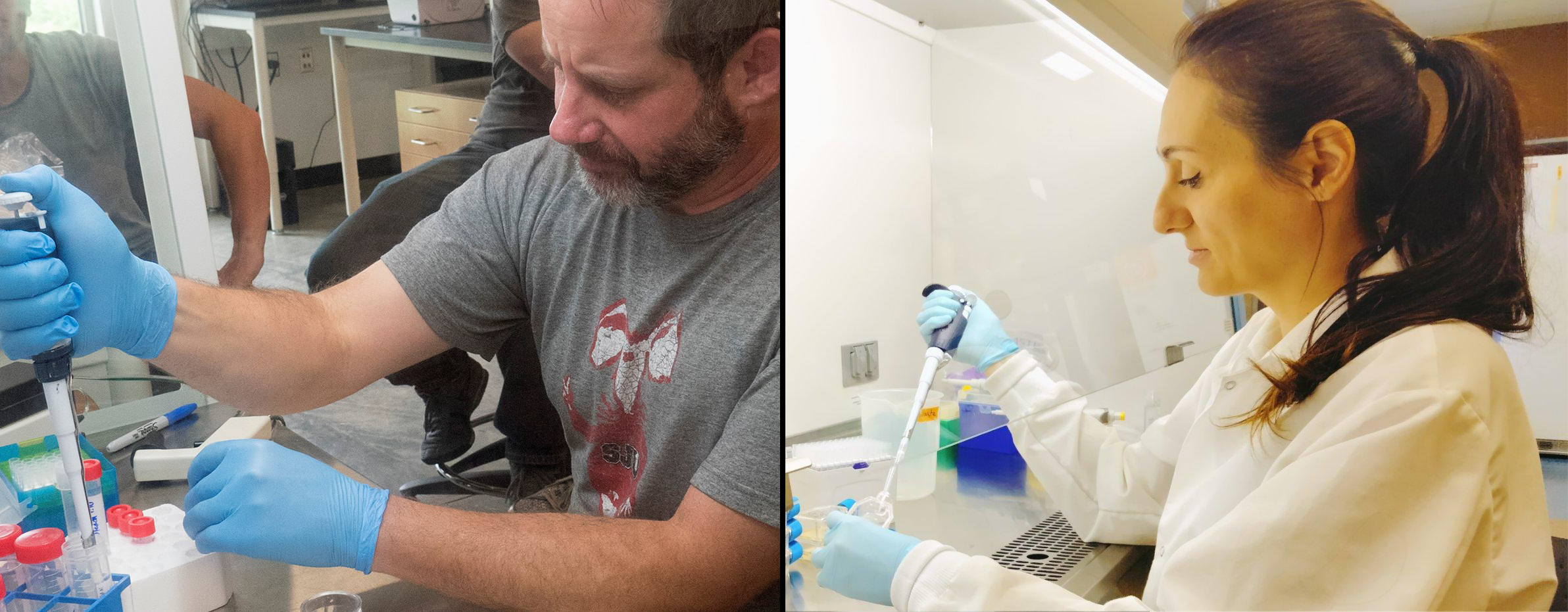
For some bumblebee species, a leading problem may be infectious diseases. For example, the bumblebee pathogen Nosema bombi is associated with declining bumblebee species. The spread of this pathogen was exacerbated through commercial rearing and distribution of the bumblebee species Bombus impatiens across the U.S.
Another emerging threat is viral pathogen transmission among pollinator species as they forage on shared flowers. For example, there is evidence that Deformed wing virus (DWV) may be transmitted from honey bees to bumblebees if diseased honey bees deposit viruses on flower parts (spillover) and other bees subsequently pick them up when visiting the same flowers.
Very little is known about pathogen prevalence in bumblebees in the U.S. and in Minnesota. To first understand and then mitigate further declines in these important pollinators, it is critical to collect baseline data on archetypal pathogens in our local populations of bumblebees and honey bees.
Project Activities
Screen for the pathogens Deformed wing virus and Nosema in bumblebees and quantify potential for virus transmission between honey bees and bumblebees.
There is potential for pathogens to be transmitted from honey bees to bumblebees while foraging on flowers, but the extent of this transmission in nature has not been explored.
- We will use cutting-edge sequencing assay technology first developed in the Schroeder Lab to quantify the prevalence and abundance of Deformed wing virus and Nosema in three common bumblebee species.
- Bumblebees will be assayed in three locations where we manage honey bee colonies (8 colonies per location), and we will monitor pathogen load in honey bees foraging on the same species of flowers during early, mid, and late summer and throughout the year.
- Furthermore, we will place pathogen-free bumblebee colonies in the same locations to monitor possible infection over the season, and how infection affects their health and reproduction.
Explore the potential to neutralize Deformed wing virus in bees.
Finding a solution or even a cure to bee pathogens is a high priority; therefore, we will run innovative, laboratory-based cage and cell culture assays to determine if Deformed wing virus can be neutralized in honey bees and bumblebees.
It was recently reported that an effective treatment for a related virus of Deformed wing virus, namely Sacbrood virus, was discovered. This treatment is based on a specific antibody raised from egg yolk against the virus, which was used to immunize honey bee pupae. We will repeat this work to determine whether Deformed wing virus can be neutralized in both honey bees and bumblebees.
Antibody synthesis, formulation, and production will be carried out in collaboration with Dr. Ben Hause (vaccine production specialist).
Beekeeper and community “public health” education about native and non-native bees in Minnesota.
Minnesota’s bee diversity boasts over 450 species and includes both native and non-native, managed and wild species. While we recognize the important role of managed honey bees in Minnesota, it is critical to provide outreach regarding the importance of our native bee pollinators and how unmindful bee management might negatively impact native bee health.
Our educational campaign will increase understanding of the roles of native and managed bees in Minnesota. Additionally, we will continue to engage backyard beekeepers in the cities of Minneapolis and Rochester to participate as beekeeper citizen scientists via pathogen and pest sampling in their honey bee colonies.